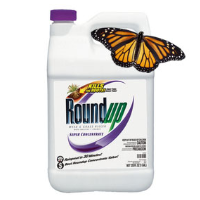State Agency Says It Is Going to Put Monsanto’s Roundup on Cancer List
 (photo illustration: Steve Straehley, AllGov)
(photo illustration: Steve Straehley, AllGov)
California announced this weekend that it is beginning a process that could eventually lead to limitations in the state on Monsanto’s Roundup, a suspected carcinogenic herbicide that is already omnipresent worldwide.
The state Office of Environmental Health Hazard Assessment (possessor of everyone’s favorite acronym, OEHHA) published its official notice of intent to put glyphosate, better known as Roundup, on the Proposition 65 list of known carcinogens.
The OEHHA cited a monograph (pdf) by the World Health Organization’s International Agency for Research on Cancer (IARC), which called glyphosate “probably carcinogenic to humans,” as the basis for its decision. France banned it for sale in garden centers in June.
Roundup is used in agriculture and backyards, on crops and weeds, here, there and everywhere. It is the most commonly applied agricultural chemical in the country. Glyphosate is also used in forest management and invasive species control in aquatic and wetland systems.
Monsanto also produces a line of Roundup Ready genetically-modified crops that are resistant to the herbicide and form a dynamic duo on farms. More than 300 million pounds of glyphosate are used annually in the United States.
Roundup residue is found on 90% of soybean crops, according to the Center for Biological Diversity (CBD). “It’s nearly impossible for people to limit exposure to this toxin because it is just so widespread,” center staff scientist Nathan Donley said.
A lawsuit filed in March by the Natural Resources Defense Council (NRDC) claimed that Roundup was responsible for wiping out milkweed across the country, which monarch butterflies rely on. The monarch population has dwindled from 1 billion in 1997 to 56.5 million this winter—a drop of 90%, according to the complaint (pdf). The NRDC filed the lawsuit after claiming the EPA refused to respond to its emergency petition for review.
The U.S. Environmental Protection Agency (EPA) was “pleased to announce” (pdf) in 1993, when it green-lighted the chemical, that glyphosate “will not pose unreasonable risks or adverse effects to humans or the environment.” After eight years of complaints about Roundup, the agency agreed in June to look anew at glyphosate, atrazine and two chemicals similar to it.
Atrazine chemically castrates frogs and may be linked to increased risks of thyroid cancer, reproductive harm and birth defects in humans, according to CBD. The U.S uses up to 80 million pounds of atrazine each year on corn, sugarcane and sorghum, as well as lawns and golf courses.
The EPA said it will complete its assessments by 2020. The OEHHA said it would accept comments on its decision until October 5.
–Ken Broder
To Learn More:
California EPA Moves to Label Monsanto's Roundup “Carcinogenic” (by Sam Levin, East Bay Express)
California to List World's Most Commonly Used Herbicide as Carcinogen (Center for Biological Diversity)
Notice of Intent to List Chemicals by the Labor Code Mechanism: Tetrachlorvinphos, Parathion, Malathion, Glyphosate (Office of Environmental Health Hazard Assessment)
After 8 Years of Delay, EPA Finally Agrees to Test Dangers of Monsanto’s Favorite Pesticide (by Steve Straehley, AllGov)
EPA Sued over Not Protecting Decimated Monarch Butterflies from Monsanto (by Noel Brinkerhoff and Ken Broder, AllGov California)
- Top Stories
- Controversies
- Where is the Money Going?
- California and the Nation
- Appointments and Resignations
- Unusual News
- Latest News
- California Forbids U.S. Immigration Agents from Pretending to be Police
- California Lawmakers Urged to Strip “Self-Dealing” Tax Board of Its Duties
- Big Oil’s Grip on California
- Santa Cruz Police See Homeland Security Betrayal in Use of Gang Roundup as Cover for Immigration Raid
- Oil Companies Face Deadline to Stop Polluting California Groundwater





